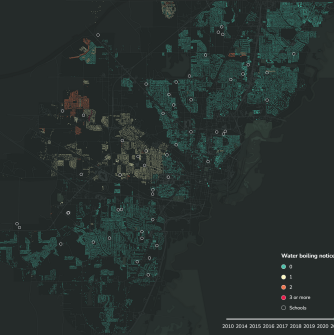| Contact |
Marcos Luna
|
|---|
In the wake of repeated boil water notices in Jackson, Mississippi, a team led by researchers from Brown University’s School of Public Health tried to gather data about the health effects of the longstanding water contamination crisis but found that little information was available.
In order to get around this information deficit, they turned to two sources of data that were accessible — school attendance records and public safety alerts that advised residents to boil water before use. The team’s analysis of this information in a study published in Nature Water shows how boil water alerts significantly disrupted student learning: Each time an alert was issued, unexcused absence rates in Jackson’s public schools increased between 1% and 10%.
Chronic school absenteeism impacts not only a child’s academic record, but also their health and well-being. Research shows that chronic absenteeism is associated with increased likelihood of poverty and decreases in mental and physical health.
Salem State's professor Luna was one member of the research team assembled by lead author Erica Walker, an assistant professor of epidemiology at Brown, which also included partners from the University of Mississippi, Massachusetts Institute of Technology, and Boston University. To conduct the study, the team used data on boil water alerts issued by the City of Jackson’s Water and Sewer Business Administration Office between 2015 and 2021, daily school attendance data from Jackson’s Public School District and demographic data from the U.S. Census Bureau’s American Community Survey.
In order to analyze the relationship between boil water notices and school absenteeism, the team had to link the geographic areas of the city subject to boil water alerts with their respective school zones. This was not a straightforward problem because Jackson, Mississippi has dozens of elementary, middle, and high schools, and student assignments to those schools follows a complex set of rules. And there were no maps of Jackson school district zones, just lists of street addresses across the city assigned to each school. Professor Luna's role was to solve that geospatial linkage problem. Using the statistical programming language R, he developed an algorithm to geographically delineate school zones based on matches between digital maps of streets in Jackson with the school assignment lists. With school zones delineated, he could then link each instance of boil water notice between 2015 and 2021 to the affected school zone. The algorithm turned out to be extremely accurate, and its results allowed the team to map the phenomenon and to do the core analyses of the study.
Luna and Walker have collaborated for years on a variety of projects dealing with urban environmental risks to vulnerable populations. This is their third peer-reviewed publication together. As the director of the Community Noise Lab at Brown, Walker originally wanted to study the effects of noise pollution on public health in Jackson. However, when the community made clear that the water contamination was a more pressing concern, Walker shifted focus. As she assembled the research team, Walker once again reached out to Luna at Salem State to provide geospatial analytic support. As Coordinator of the graduate Geo-Information Science program at Salem State University, Luna and his graduate GIS students are well acquainted with the technology and techniques to solve such problems. Equally important, the opportunity to apply these tools to support vulnerable communities, and to respond to their stated concerns, resonated with Luna's own focus on issues related to environmental justice.
In the study, the researchers concluded that their analysis highlights the urgency of addressing the root causes of the poor water quality in Jackson. They provide suggestions for how municipalities can more effectively spread the word about contaminated water, including social media posts, voicemails or conducting door-to-door outreach when resources enable it. They also suggested that the Mississippi Department of Health publish a sample press release for local water systems that includes information about the cause of the boil water alert, the population and public schools impacted, and what precautions to take.
The team said the findings could benefit other cities struggling with poor water infrastructure and shed light on the many issues directly and indirectly caused by boil water alerts. The peer-reviewed article in Nature Water is an open access publication, and is therefore freely accessible to everyone. Using the data generated by Luna's algorithm, team members from MIT created a data visualization to engage the community both within Jackson and across the world about the research findings.

